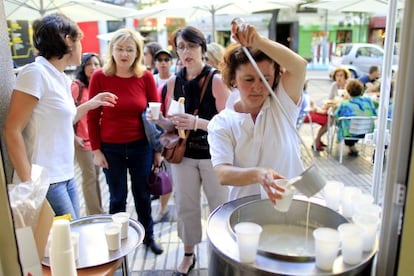Keeping 'chufa' rooted on the sidewalks of Madrid
Three shops in the city are still making traditional 'horchata'


Celia Monrós has five tons of chufa - tigernut sedge or earth almond, a bulbous root - in her cellar. She is 34, and runs one of the few horchatería drink stands left in Madrid.
A cool summer beverage, typical of the Valencia region, horchata has a characteristic flavor deriving from the chufa. It has a name in English - orgeat - but for all that conveys to most readers, you might as well stick to the Spanish.
She likes the work, and knows that this traditional drink needs new consumers and promotion to survive. Horchata fans were in luck the other day when Monrós' Horchatería Alboraya gave away 300 liters of the drink, accompanied by fartones (sugared pastries). "Lots of people turn their noses up at horchata because of the industrial brands, which are stiff with additives. But once they try the real thing, they are hooked," she says.
A graduate in agricultural engineering, Celia opted to continue the family tradition. Her parents, born in the Valencian village of Alboraya (Spain's chufa capital), started an horchatería on Calle de Alcalá in the 1980s, when it still had a central pedestrianized "boulevard" dotted with stands selling the whitish liquid.
"I hesitated at first, but my parents wanted to sell the business, and this is a product that needs promotion, or it will just disappear," she explains.
Water, sugar and chufas are the three ingredients. They pass through three machines that wash, clean and crush the chufas. A small room behind the bar houses the machines, but the main thing is conservation. "The drink has a use-by limit of 48 hours, and if the refrigeration is interrupted, it goes off, like milk." This is why bottled industrial brands, which have driven the traditional product off the market, need to have a high content of additives. In Alboraya, her native town, her parents have some 20 hectares planted with chufa, but some summers she has to buy material from other suppliers.
Family culture
"Some ice-cream shops have expressed interest in buying our product, but for the moment we have our hands full satisfying the demand right here."
She has spent more than a decade with one foot in Madrid and the other in Alboraya, busy keeping the business going in spite of the crisis. Her two-year-old son may be the next link in the chain, she hopes.
A few blocks away, in Calle de Narváez, Miguel García runs the only old Madrid kiosk still selling traditional horchata. In a booth of about four square meters he sells some 80 liters a day, closing in winter. His grandparents opened the stand in 1944, when there were hundreds of kiosks like his.
La Fábrica de la Horchata is the third horchatería still in business. Its owner, José Ángel Ferrer, is proud of its continuity. "We have been open since 1938, and will be till the end of my days." Like the other two, he believes that horchata culture is rooted in Madrid, but needs promotion. "We just have to keep going."
Tu suscripción se está usando en otro dispositivo
¿Quieres añadir otro usuario a tu suscripción?
Si continúas leyendo en este dispositivo, no se podrá leer en el otro.
FlechaTu suscripción se está usando en otro dispositivo y solo puedes acceder a EL PAÍS desde un dispositivo a la vez.
Si quieres compartir tu cuenta, cambia tu suscripción a la modalidad Premium, así podrás añadir otro usuario. Cada uno accederá con su propia cuenta de email, lo que os permitirá personalizar vuestra experiencia en EL PAÍS.
¿Tienes una suscripción de empresa? Accede aquí para contratar más cuentas.
En el caso de no saber quién está usando tu cuenta, te recomendamos cambiar tu contraseña aquí.
Si decides continuar compartiendo tu cuenta, este mensaje se mostrará en tu dispositivo y en el de la otra persona que está usando tu cuenta de forma indefinida, afectando a tu experiencia de lectura. Puedes consultar aquí los términos y condiciones de la suscripción digital.
Últimas noticias
From Andorra to Gibraltar, a black market for Ozempic exploits its success: ‘They’re the most sought-after products in the world’
From Hungary’s Orbán to Chile’s Kast: How Trump helps turbo charge the far right
Magnets in their heads: How some animals guide themselves using the Earth’s magnetic field
The brief rise and retreat of Generation Z in Mexico
Most viewed
- Why we lost the habit of sleeping in two segments and how that changed our sense of time
- Trump’s obsession with putting his name on everything is unprecedented in the United States
- Charles Dubouloz, mountaineering star, retires at 36 with a farewell tour inspired by Walter Bonatti
- Venezuela faces its most tense Christmas yet
- The Florida Keys tourist paradise is besieged by immigration agents: ‘We’ve never seen anything like this’








































